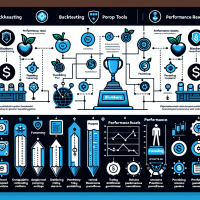Prop Trading: Blueberry Funded $200k Alternatives
In today’s competitive trading landscape, prop traders and aspiring professionals must stay ahead of funding constraints and refine their strategies with precision. Blueberry Funded accounts offer a unique opportunity with account sizes up to $200k as of March 2025. This article provides seasoned insights into advanced prop trading, diving deep into backtesting techniques, automated platform comparisons, and real-world case studies from established prop firms. If you’re looking to enhance your strategy and overcome traditional limitations, read on for expert guidance.

Understanding Prop Trading Funding Alternatives
The proprietary trading space is evolving. While traditional funding methods may limit trader potential, alternatives like Blueberry Funded accounts up to $200k empower traders to drive aggressive, yet calculated, strategies. Unlike conventional models, these funded programs typically offer better profit sharing, increased capital, and less restrictive evaluation programs.
Key benefits include:
- Enhanced Capital Access: With account sizes up to $200k, traders have more breathing room to test and scale their strategies.
- Structured Evaluations: Rigorous evaluation programs ensure that traders meet realistic risk management and performance standards.
- Actionable Feedback: Real-time performance monitoring and automated backtesting tools help in refining strategies quickly.
For both junior traders and seasoned quants, understanding these alternative funding routes can open doors to improved risk management and overall performance. With increasing regulatory oversight, such as MiFID II in Europe or the NFA guidelines in the US, prop trading firms must also prioritize innovation in compliance and backtesting methodologies.
Advanced Backtesting Techniques for Robust Prop Trading
Backtesting is an indispensable tool for any prop trader. However, advanced backtesting — one that mitigates pitfalls like overfitting, survivorship bias, and look-ahead bias — is crucial when deploying large-capital strategies. Here are key aspects:
Identifying and Mitigating Common Pitfalls
Traders should be aware of biases that may distort backtesting results:
- Overfitting: Excessively tailoring your strategy to historical data can reduce its robustness in live markets.
- Survivorship Bias: Ensure data sets include delisted or non-performing stocks to get realistic performance insights.
- Look-Ahead Bias: Safeguards must be in place to avoid using future data when testing past strategies.
Advanced methods such as walk-forward optimization and out-of-sample testing enhance strategy reliability. Walk-forward analysis helps dynamically adjust parameters as new data becomes available, while rigorous out-of-sample testing ensures that strategies have not been inadvertently tuned to past market conditions.
Integrating Automated Parameter Optimization and Stress Testing
Modern backtesting platforms automate key tasks like parameter optimization and stress testing. Automated report generation and scenario analysis provide detailed insights, allowing teams to identify weaknesses early. For example, integrating Python with Backtrader or Pine Script on TradingView can help simulate thousands of scenarios to test for optimal Sharpe ratios, minimal drawdowns, and realistic broker conditions.

Comparing Automated Backtesting Tools for Prop Trading
Selecting the right automated backtesting tool is vital for both prop firms and individual traders. Each platform offers unique features tailored to various needs. Below is a comparison of some widely recognized tools:
| Tool | Backtesting Features | Data Quality & Integration | Pricing & Use Cases |
|---|---|---|---|
| TradingView | Vectorized backtesting, comprehensive charting, Pine Script automation | High-quality historical data, integrated broker APIs | Free tier available, scalable for retail traders and prop firms |
| MetaTrader 5 | Event-driven backtesting, MQL5 based custom scripting, handling commissions/slippage | Rich data feeds across asset classes, robust broker integration | Widely used, suitable for both retail and institutional setups |
| NinjaTrader | Advanced optimization capabilities, integrated strategy builder | Deep historical data archives, real-time analytics | Flexible pricing options including trial licenses for prop trading teams |
| QuantConnect | Algorithmic backtesting with multiple asset classes, cloud-based simulation | Extensive historical and real-time data integration | Subscription-based with customizable packages suitable for quants |
Each tool automates not just data replay but also parameter optimization, scenario stress testing, and automated report generation. The integration of quality data sources, such as tick data vs. bar data, plays a crucial role in ensuring strategy robustness. These platforms are designed to meet the unique scaling needs of prop firms where team collaboration, compliance features, and real-time data flows are non-negotiable.
Real Market Scenarios and Detailed Case Studies
To illustrate practical applications, consider the case of a mid-sized prop trading firm that integrated automated backtesting to refine its intraday scalping strategy. The team initially faced challenges with overfitting and inconsistent drawdowns. By implementing walk-forward optimization using NinjaTrader, combined with rigorous out-of-sample testing on MetaTrader 5, the firm was able to improve its Sharpe ratio from 1.2 to 1.8 and reduce maximum drawdown by 20%.
Another case involved an emerging algorithmic trader using QuantConnect for automated backtesting. By leveraging automated parameter scans and scenario analysis, the trader successfully adjusted his strategy for varying market conditions, leading to a 30% increase in trade execution speed and a significant reduction in latency issues.
Code Snippet: Automated Backtesting with Backtrader
import backtrader as bt
class TestStrategy(bt.Strategy):
def __init__(self):
self.sma = bt.indicators.SimpleMovingAverage(self.data.close, period=15)
def next(self):
if self.data.close[0] > self.sma[0] and not self.position:
self.buy()
elif self.data.close[0] < self.sma[0] and self.position:
self.sell()
# Initialize Cerebro engine
cerebro = bt.Cerebro()
cerebro.addstrategy(TestStrategy)
data = bt.feeds.YahooFinanceData(dataname='AAPL', fromdate=datetime(2020, 1, 1), todate=datetime(2021, 1, 1))
cerebro.adddata(data)
cerebro.run()
cerebro.plot()
This Python snippet demonstrates an automated strategy using Backtrader, where the simple moving average is used as a signal generator. Such automated processes are pivotal in optimizing strategy performance and ensuring consistency in live markets.
Integrating Forward Testing and Real-Time Adjustments
After extensive backtesting, the next step in a robust prop trading strategy is forward testing, often performed through paper trading before live deployment. Forward testing provides validation that a strategy’s performance holds in the current market environment. Here are a few critical steps:
- Paper Trading Phase: Use platforms like Interactive Brokers for simulated trading with live data feeds.
- Real-Time Monitoring: Continuously track metrics such as profit factor, maximum drawdown, and Sharpe ratios.
- Iterative Refinement: Use results from forward testing to further calibrate backtesting models.
By integrating both backtesting and forward testing, prop firms and independent traders can ensure their strategies are resilient against unexpected market conditions. For additional insights, refer to our internal guide on advanced backtesting techniques and risk management best practices.
Next Steps for Prop Trading Success
As the market evolves, so do the tools and techniques required for successful prop trading. Whether you are a junior trader eager to climb the ranks or a risk manager looking to optimize capital allocation, the strategies discussed here provide a solid foundation.
For more actionable insights, explore our related resource on Prop Trading Risk Management. Additionally, consider downloading our comprehensive Risk Management Checklist, which covers:
- Key risk ratios and thresholds
- Step-by-step monitoring protocols
- Compliance tips aligned with MiFID II and NFA rules
In conclusion, alternative funding solutions like Blueberry Funded accounts up to $200k combined with advanced backtesting and forward testing methodologies offer a competitive edge in prop trading. These strategies empower you to navigate market volatility, optimize execution, and maintain compliance in an increasingly regulated landscape. Stay informed, test rigorously, and adapt continuously.
For continuous updates and expert insights, subscribe to our newsletter and join our upcoming webinar on advanced prop trading strategies.
Disclaimer: Trading involves risks and the past performance of a strategy is not indicative of future results. Ensure you adhere to local regulatory guidelines and perform thorough due diligence.







